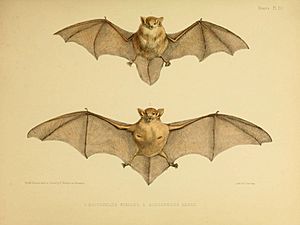Little broad-nosed bat facts for kids
Quick facts for kids Little broad-nosed bat |
|
|---|---|
 |
|
| Conservation status | |
| Scientific classification | |
| Genus: |
Scotorepens
|
| Species: |
greyii
|
The little broad-nosed bat (Scotorepens greyii) is a small bat found only in Australia. It's sometimes called Grey's broad-nosed bat, named after Sir John Edward Grey. This bat is part of the vesper bat family, which is one of the biggest and most famous bat families! These bats love to eat insects and live in many different parts of Australia, especially in hot, dry areas. You can also find them in tropical rainforests.
Contents
What Does It Look Like?
The little broad-nosed bat has a slim body. When you look at its face from above, it has a wide, square nose. Its fur can be brown or grey-brown on its back. The fur near its skin is lighter than the tips. Its belly fur is also lighter.
These bats have small forearms and fairly wide ears. The small, pointed part inside their ear, called the tragus, is narrow and pointed. They look a lot like other broad-nosed bats, which can make them hard to tell apart in the wild!
How Big Are They?
Here are some average measurements for the little broad-nosed bat:
- Weight: About 6.4 grams (that's less than a pencil!)
- Forearm length: About 31.3 millimeters
- Ear length: About 11.4 millimeters
- Tail length: About 32.2 millimeters
- Wingspan: About 234 millimeters (that's almost 10 inches wide!)
Their size can vary a bit. For example, their weight can be from 4 to 8.5 grams.
Where Do They Live?
You can find the little broad-nosed bat across most of mainland Australia. However, they are not found in the southern parts of Western Australia and South Australia. You also won't find them in Tasmania, Cape York Peninsula, or most of Victoria.
Even though they live in many places, there aren't huge numbers of them in any one spot. They mostly live in hot, dry areas like deserts and grasslands. But they also live in warmer, wetter places. These include:
- Dry grasslands
- Sandy deserts
- Areas near inland rivers with redgum trees
- Monsoon forests
- Melaleuca forests
- Open forests
- Mixed shrubland
- Paperbark swamps
They are often seen flying near water sources.
What Do They Do?
Like most bats, the little broad-nosed bat is nocturnal. This means they are active at night. They usually start flying around soon after the sun sets. They use both their good eyesight and a special skill called echolocation to find their food. Echolocation is like using sound waves to "see" things in the dark!
What Do They Eat?
The little broad-nosed bat is an insectivore, which means it eats insects. They catch their food and drink water while flying! They hunt for insects near the tops of trees, over water, and in open grassy areas.
These bats are very fast flyers. They make quick darts and turns in the air to catch their prey. They eat a lot of beetles, bugs, and ants. They also enjoy moths, termites, cockroaches, crickets, flies, and lacewings. They have even been seen catching moths that are as big as they are!
Where Do They Sleep?
Little broad-nosed bats like to sleep, or roost, in hollow spaces. They often choose hollows inside trees. But they have also been found sleeping in fence posts. Sometimes, they even roost in the space under the metal caps of old telegraph poles. They can also use old, unused buildings. Once, about 20 bats were found roosting together in one spot!
Scientists think these bats might move around during different seasons. This could be because their food sources change, or because of changes in the weather.
Reproduction and Life Cycle
The mating habits of the little broad-nosed bat can be different depending on where they live. In drier areas, they might start mating before winter, around April. The baby bats are then born in October.
In warmer, more temperate areas, they are known to mate during the winter. The babies are usually born in late spring or summer. These bats often give birth to twins! The young bats grow up quickly and can start finding their own food within one to two months.
Conservation Status
Good news! The little broad-nosed bat is not considered an endangered or threatened species. This means they are not in immediate danger of disappearing.
However, there are still some things that could harm them. They can lose their roosting spots in tree hollows if forests are cut down. They can also lose their feeding grounds when land is cleared for farming or new houses. It's important to protect their homes and hunting areas to keep them safe for the future.
See also
 In Spanish: Scotorepens greyii para niños
In Spanish: Scotorepens greyii para niños


